Research Article
Wideband Channel Estimation for Full Rate Full Diversity Antenna Selection Wireless Systems
Department of Electrical Engineering, Faculty of Engineering Technology, Albalqa Applied University, P.O. Box 15008, Amman 11134, Jordan
Future mobile communications aim to satisfy high capacity and high quality of service (Gesbert et al., 2003; Foschini and Gans, 1998; Telatar, 1999). This can be achieved by using multiple transmit and receive antennas (Liejun, 2011; Wang et al., 2010; Cao et al., 2011). Space-time block coding systems for flat fading channels (Alamouti, 1998; Tarokh et al., 1999) have taken a great deal of research interest as codes that achieve high data rate and high performance with low decoding complexity. In the case of wideband channels, these codes were presented in conjunction with OFDM technology (Mudulodu and Paulraj, 2000; Lee and Williams, 2000; Alkhawaldeh and Shayan, 2003) which transforms the wideband channel into parallel multi flat fading channels. Accurate channel estimation is required and necessary for the decoding of the OFDM systems (Li et al., 1999). Channel estimators that use one and two dimensional interpolating filters (Aghamohammadi et al., 1991; Tufvesson and Maseng, 1997; Hoeher et al., 1997; Li, 2000) have been proposed. These estimators apply pilot symbols at the transmitter and get the estimates of the channel at pilot locations at the receiver, then use interpolating filter to get the channel estimates at every location of OFDM frame. In recent years, channel estimators for OFDM systems have been presented (Alnuaimy et al., 2009; Desta et al., 2011; Liu et al., 2006). These estimators were designed for Single Input Single Output (SISO) OFDM systems.
For MIMO OFDM systems, several channel estimators have been presented for space-time block coded OFDM systems (Delestre and Sun, 2009, 2010; Chen et al., 2010). However, these estimators were presented for two transmit antennas with full rate. Therefore, in this study, we propose a wideband channel estimator for the full rate full diversity antenna selection wireless system with more than two transmit antennas (Celebi et al., 2007) combined with the OFDM technology. The proposed scheme is based on the pilot-symbol-aided channel estimation. The channel estimation is achieved for a system with three transmit and one receive antennas where OFDM-STBC antenna selection system is used. Simulation results under different channel environments are presented to show the efficiency of the proposed scheme.
WIRELESS WIDEBAND CHANNEL MODEL
The complex base band representation of the impulse response of the mobile wireless channel between transmit antenna i and receive antenna can be described by Li (2002) and Cavers (1991):
| (1) |
where, τim, γim(t) are the time delay and complex amplitude of the mth multipath of the channel between transmit antenna i and receive antenna, respectively, p(τ) is a unit energy pulse that satisfies:
| (2) |
Under the assumption that the wideband channel is slow or constant over two consecutive OFDM frame periods and γim(t)’s are described by Wide-Sense Stationary (WSS) and narrowband complex Gaussian processes, then t is dropped and Eq. 1 can be written as:
| (3) |
The Fourier transform of the impulse response of the channel presented in Eq. 3 is:
| (4) |
| (5) |
With proper cyclic extension and tolerable leakage, the channel frequency response of OFDM system can be expressed as (Van de Beek et al., 1995; Li et al., 1998):
| (6) |
where, WK = exp(-j2π/K), hi(l) = h(kTS/K), Δf and TS are the tone spacing and symbol period, respectively. In Eq. 6, L is the number of resolvable paths of the wideband wireless channel.
FULL RATE FULL DIVERSITY ANTENNA SELECTION FOR WIDEBAND WIRELESS SYSTEMS
Figure 1 shows the block diagram of the full rate full diversity antenna selection wireless system (Celebi et al., 2007) combined with the OFDM technology. OFDM technology is applied to eliminate the inter-symbol-interference in the frequency selective fading channels (Arioua et al., 2012; Ramesh and Vaidehi, 2006; Salari et al., 2008). In this scheme, at transmit antenna i, each OFDM frame xi has K symbols and the process of encoding is achieved frame by frame. It is assumed that the wideband channel is constant across two consecutive OFDM frame periods.
At the output of the Discrete Fourier Transform (DFT), the received signal over two consecutive OFDM frame periods at tone k can be written as:
| (7) |
| (8) |
where, a is a vector whose elements are ±1.
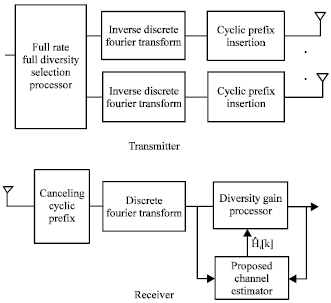 | |
| Fig. 1: | OFDM full rate full diversity antenna selection wireless system |
These values are chosen based on the relative information of the channel at the transmitter as follows: If Re(H2[k]H*3[k]) is positive, the value a[k] = 1, otherwise, it is -1. This maximizes and increases the gain of this scheme compared to other conventional scheme (Lee and Williams, 2000). η1[k] and η2[k] denote the additive complex Gaussian noise at the receive antenna over the OFDM periods 1 and 2, respectively.
PROPOSED WIRELESS WIDEBAND CHANNEL ESTIMATOR
Here, we propose a wideband channel estimator for the system presented earlier as shown in Fig. 1. The proposed channel estimator is based on the pilot-symbol-aided channel estimation for wideband channels. Robust channel estimation is very important for the decoding of the OFDM systems (Li et al., 1999). As the accuracy of the channel estimation increases the bit error rate of the system decreases which leads to significantly improved performance.
In our approach, at the transmitter, the pilot symbols are inserted periodically during the OFDM frame as shown in Fig. 2 where the letter p represents the pilot symbol, blank square represents the information symbol and 0 represents the zero value. In Fig. 2, the matrix A is a KxK diagonal matrix whose diagonal elements are the elements of vector a.
The received pilot symbols at tone k’ are given as:
| (9) |
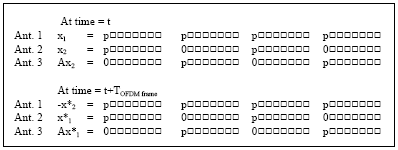 | |
| Fig. 2: | Pilot symbols arrangement during OFDM frame |
| (10) |
Since, these symbols are known to the receiver, the estimates of the channel at pilot locations are obtained as:
| (11) |
| (12) |
| (13) |
| (14) |
where, N = K/(No. of pilot locations in OFDM frame). After substitution y1 and y2 the estimated values of the three channels can be written as:
| (15) |
| (16) |
| (17) |
| (18) |
Where:
| (19) |
| (20) |
| (21) |
| (22) |
To get the estimated values of the frequency response of the three channels at all locations, the interpolating filter is used.
After the estimated values of the frequency response of the three channels at pilot locations are obtained, zeros are inserted at other locations to form up-sampled signals ![]() . Note that the number of estimated values at pilot locations of the channel
. Note that the number of estimated values at pilot locations of the channel ![]() are twice those of the channels
are twice those of the channels ![]() and
and ![]() . Thus, signal
. Thus, signal ![]() is transmitted to low pass filter with transfer function given by:
is transmitted to low pass filter with transfer function given by:
| (23) |
whereas, the signals ![]() and
and ![]() are transmitted to low pass filter with transfer function given by:
are transmitted to low pass filter with transfer function given by:
| (24) |
The outputs of these filters ![]() ,
, ![]() and
and ![]() are sent to the diversity gain processor for maximum likelihood decoding.
are sent to the diversity gain processor for maximum likelihood decoding.
NUMERICAL RESULTS
Here, full rate full diversity antenna selection wireless system (Celebi et al., 2007) combined with the OFDM technology is used. The proposed scheme is equipped with 3 transmit and one receive antennas using one bit feedback. The mean square error of the proposed channel estimator for this system is presented. For this approach, equal gain channel (Alkhawaldeh et al., 2005) and ITU channel with both 50 Hz and 250 Hz Doppler frequencies are considered. The entire bandwidth of 0.8 MHz is divided into 128 sub carrier tones for OFDM modulation. This provides an OFDM period of 160 μsec. We use four tones at the beginning of the OFDM frame and four at the end as guard tones.
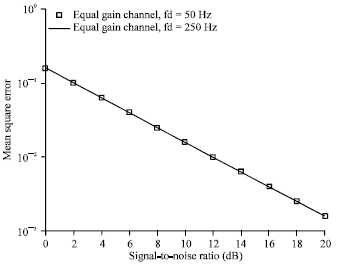 | |
| Fig. 3: | Mean square error of the proposed channel estimator for equal gain channel with fd = 50 Hz and fd = 250 Hz |
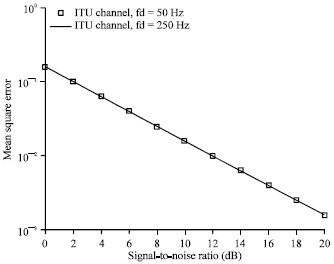 | |
| Fig. 4: | Mean square error of the proposed channel estimator for ITU channel with fd = 50 Hz and fd = 250 Hz |
To avoid the inter-symbol interference, a guard interval of 40 μsec is added. This yields a sub-channel separation of 5 kHz. In all simulations, BPSK modulation and the grid shown in Fig. 2 are used.
In Fig. 3, for equal gain wideband channel with two Doppler frequencies of 50 Hz and 250 Hz, the Mean Square Error (MSE) of the proposed channel estimator is presented. As expected, the MSE is the same in both cases which shows that the proposed scheme is very robust to the time variation of the wideband equal gain channel.
Figure 4 shows the MSE performance comparison when the ITU channel is used.
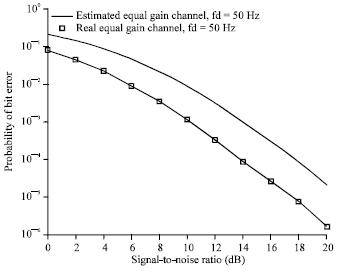 | |
| Fig. 5: | Probability of bit error with real and estimated values of wideband equal gain channel with fd = 50 Hz |
With the same parameters above, it is also shown that no difference in the MSE in both cases which presents how much the proposed channel estimator is robust and efficient to the time variation of the wideband ITU channel.
In Fig. 5, we present the probability of bit error as a function of signal to noise ratio of the full rate full diversity antenna selection wireless system (Celebi et al., 2007) combined with the OFDM technology with the real and estimated values of the equal gain wideband channel with Doppler frequency of 50 Hz. As can be seen, performance gain of approximately 3.5 dB is achieved in the case of real values of the channel compared to the case of estimated values of the channel which is very acceptable. This shows that the estimated values of the channel using the proposed channel estimator provides very good probability of bit error performance.
In this study, we have proposed a wideband channel estimator for the full rate full diversity antenna selection wireless system (Celebi et al., 2007) combined with the OFDM technology. The combination of the coding scheme and OFDM technology maximizes the diversity order of the wideband wireless systems. Using the perfect knowledge of the channel at the transmitter requires large number of feedback bits which is not practical. Instead of this, the presented coding scheme uses one feedback bit at the transmitter. In the proposed channel estimator, it was shown that for equal gain or ITU wideband channels with fd = 50 Hz and fd = 250 Hz, the MSE has the same values. This shows the robustness of the proposed scheme to the time variation of the wideband channels. Also, it was noted that the performance gain of only 3.5 dB is achieved in the case of real values of the channel compared to the case of estimated values of the channel. This presents the validity and efficiency of the proposed channel estimator.